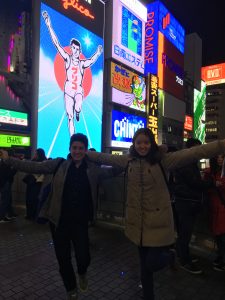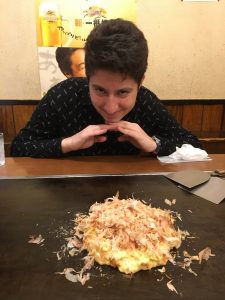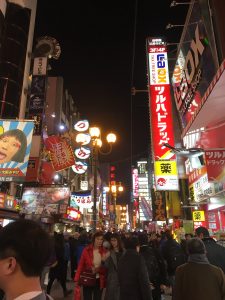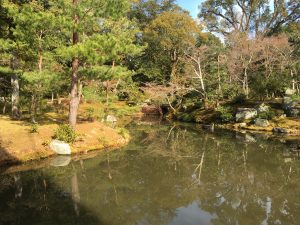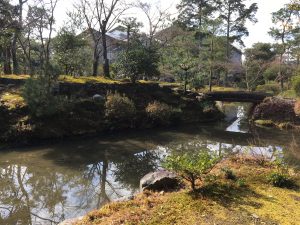Today was the great day of visiting the Takabayashi Family, which is of the Kita school. While most of the Kita school resides in Tokyo, the Takabayashi Family resides in Kyoto. They have a close sense of family, and are a long family of 3 generations, in which we were able to meet the father and son, who gave the workshop. At 9:15am, we hailed 3 taxis from our hostel to the Toji-in Station, so as to promptly be early, as being late would be unacceptable. Successfully, we arrived early at Toji-in and waited a bit around the station, which was right next to the Takabayashi Family home. After we had all gathered we proceeded inside.
Luckily, we were able to see shimai, which are dances done without costumes, instrumental ensemble, or props, in the beginning as part of the workshop. We watched the graceful subtleness of the dance from Hagoromo, performed by the father, and afterwards watched the dance from Iwafune by the son. Surprisingly, the dance from Iwafune looked very different from the one we saw at the Kanze Noh theater. It might be attributed to difference of style within families and schools, as we also picked up a bit that many of the schools do things slightly differently, from training, to practice, to performance.
Afterwards, we were able to see some of the masks that the Takabayashi Family uses up close. I was very interested in the ko-omote masks, which were used for young woman roles, whether they be shite or other supporting roles. Interestingly, there was another mask, the manpi, that looked very similar, with subtle differences such as the eyebrow thickness. We learned later that there was a subtle difference in meaning, that the manpi was also for young woman, but more specifically could have a bit of a risque kind of feel. Within these masks, there are also even more specific variations, so that an actor could choose according to his mood or what kind of feeling he wants to portray on the performance day. We also saw masks such as the kurohige, used for the dragon god with rounder eyes with more viewing potential, the mask used for lesser demons or goblins or bandits, or yokai and other malicious beings, and the yoroboshi, from a story of a young boy that becomes blind after being rejected by a father but later is accepted by him. This mask was also interesting in that the eye holes were actually thin crescent slits, over holes. We were told stronger characters usually have larger, more dynamic eyes. We also saw the mask for old men, with facial hair, which was similar to the one we saw in Yumi Yawata, and the juu-roku (literally translated into 16), which depicts young boys, usually young warriors killed in battle; the mask is still cultured and subtle, but still possesses strength in its design.
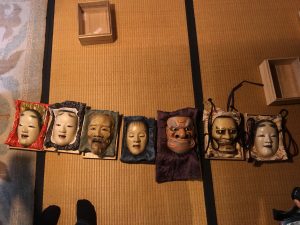
While, in Noh, masks are worn, so the personal facial expression does not show, expression is made through all of the body and movement and angling of the mask when worn. The choreography and expression is extremely important in showing the mood of the character. It got me thinking a bit of the body itself as an ensemble, as well, working together in various stages, such as movement and angle, in order to convey meaning.
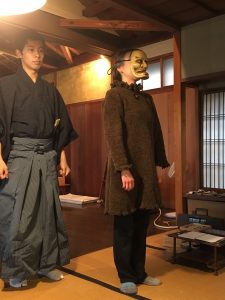
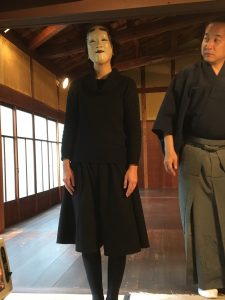
We were also able to try on the ko-omote or kurohige mask and walk on the practice stage, getting a sense of location with a limited field of vision. Around this time, I also understood the use of the floorboards and pillars as an important guiding tool to decipher where I was. Here’s Kagaya-sensei and Sachi-san with their masks!
Afterwards, we were able to see 3 of the costumes, which were absolutely exquisite. The kara-ori was mainly for women roles and was an orangish-red, full of what seemed to be embroidered colored flowers which caught the light and shone. There was the atsuita, which were for men or gods or strong characters, with very strong, dynamic patterning. These costumes weight 3-4 kilograms! Actors usually wear approximately 4 or more layers, which makes it extremely hot, as well, though in the chilly winter, it can be nice. Within the family, they usually buy their own costumes, but usually, they can borrow within the school.
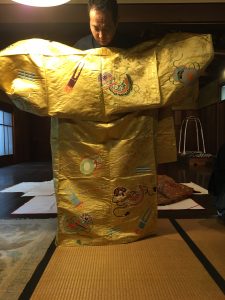
We then got to see fans: the fan usually used for Hagoromo depicted the red mist for young women, with flowers of all seasons, spring and summer on one side, and autumn and winter on the other; and the fan usually used for Iwafune depicted the setting sun in waves. I asked about the depiction of gold in many of the costumes and fans, and learned about the use of it in lighting, as well as its purpose in previous aristocracy, as well as its prominence later in Noh’s development. There is some minor choice in what fan to use as well.
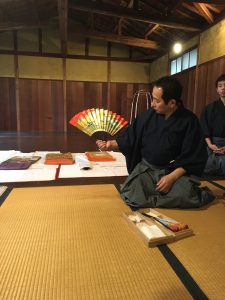
Finally, we were able to see the wig, which was black and made of horse hair, usually for women. It was extremely interesting that for jealous women, or hanya, they’d wear wigs of real human hair! It really brings in another element of scariness, a bit. There is also a yak hair wig that can be used for characters like the dragon god in Iwafune.
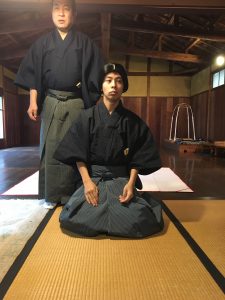
It was truly a very hands-on experience that I felt I learned a lot about. Afterwards, we asked questions pertaining to the relationships to audience and persisting traditions of Noh, which we’ll be putting in our presentation. In essence, nothing has changed about Noh with regards to the actor, always performing at their best no matter who (or no one!) is watching. More initiatives have been made in order to get younger generations involved as well, but one can say that Noh is equipped to, and has successfully lasted throughout time without changing its core.
After the workshop, Leah and I split off to Toji-in. While the temple was under construction, I still had one of my top experience of Japan–the garden. It was a BEAUTIFUL place, truly, well, suteki for lack of better words. The peacefulness of it all really calmed and refreshed me. We were so moved that we decided to have tea and snacks there, as they had a service. The matcha was also delicious, and all the better that we could drink it while looking at the garden, smelling the fresh air, and listening to the sounds of the water.
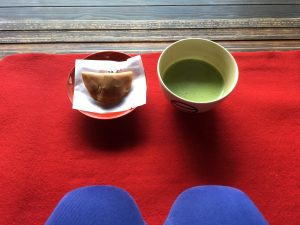
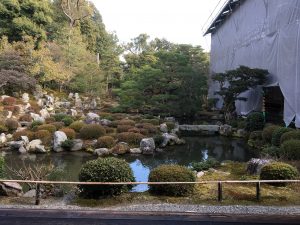
We also decided to go by Ryoan-ji, to see the famous 15-rock garden that is impossible to see all at once no matter where you stand. I indeed found that to be true.

Afterwards, we head to Arashiyama, getting some yuzu honey vinegar ice cream (Leah with shoyu) and eating lunch at a small shop along the street before the bridge. Cheap and delicious! And we went to the best spot later: Fufu no Yu, an day onsen. As I’ve already been to the main sights of Arashiyama, the onsen was perfect as I’ve also been itching to go to one since I last left Japan. It was really just a religious experience. 2 indoor, 2 outdoor baths, a sauna, soaps, a bit of a view and fresh air, tranquil vibes–couldn’t have asked for more. We chilled out after the bath in the lounge, with some coffee milk and wifi catchups.
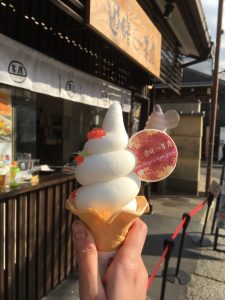
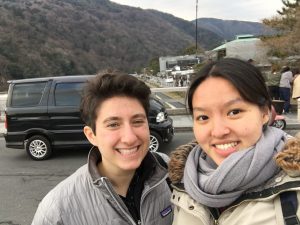
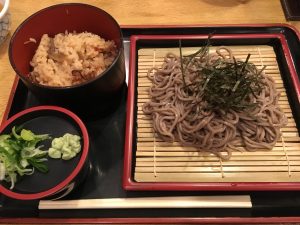
Finally, we head to Osaka, specifically Dotonbori. I managed to make a side stop at Hotel Lovers to pick up contacts for a cosplay as well! Dotonbori was majestic, crowded, and full of lights as usual, and Leah and I shared many a story over some delicious okonomiyaki and sights, as well as a lot of sock shopping. Now, we’re on our way back as I write this in the notepad app on my phone!
